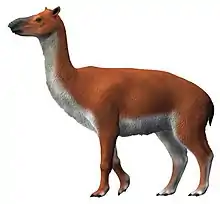| Yecua Formation | |
|---|---|
| Stratigraphic range: Late Langhian-Early Messinian (Colloncuran-Huayquerian) ~ | |
| Underlies | Tariquia Formation |
| Overlies | Petaca Formation |
| Thickness | ~50–300 m (160–980 ft) |
| Lithology | |
| Primary | Mudstone, Sandstone[1] |
| Other | Gypsum |
| Location | |
| Region | Chaco Basin |
| Country | |
The Yecua Formation is a geological Formation in what is now Bolivia. Studies suggest that the Yecua Formation preserves a coastal setting with humid to semiarid floodplains, shorelines and tidal as well as shallow marine environments including marshes, streams, lakes and brackish bodies of water. There may have been a connection to the Amazon Basin or the Paranaense Sea.[2]
Bivalves
| Name | Species | Member | Material | Notes |
|---|---|---|---|---|
| Tellina[1] | T. sp | |||
| cf. Cyrena[1] | cf. C. sp | |||
| cf. Astarte[1] | cf. A. sp | |||
| cf. Lucina[1] | cf. L. sp | |||
| Senis[1] | S. cf. elongatus | |||
| cf. Corbula or Cymbophora sp.[1] | cf. C. sp | |||
| cf. Nucula[1] | cf. N. sp | |||
Gastropods
| Name | Species | Member | Material | Notes |
|---|---|---|---|---|
| cf. Gyrodes or Natica sp.[1] | ||||
| cf. Turritella[1] | cf. T. sp | |||
Crustaceans
| Name | Species | Member | Material | Notes |
|---|---|---|---|---|
| Bythocypris[1] | B. sp | |||
| Cyprideis[1] | C. sp | |||
| cf. Balanus[1] | cf. B. sp | |||
| indetermined crabs [1] | ||||
Vertebrates
| Name | Species | Member | Material | Notes | Image |
|---|---|---|---|---|---|
| cf. Theosodon[1] | cf. T. sp | distal limb bone | a litoptern |  | |
| Rodentia indet.[1] | tooth | ||||
| Mourasuchus[3] | M. sp. | skull fragments, partial vertebrae & ribs | |||
| Pleurodira[3] | shell elements | ||||
| Humboldtichthys[4] | Humboldtichthys kirschbaumi | incompletely preserved anterior portion of the body and posterior head | a Glass Knifefish | ||
| Siluriformes indet.[1] | possibly Ariidae | ||||
| Characiformes or Clupeiformes[1] | a scale | ||||
References
- 1 2 3 4 5 6 7 8 9 10 11 12 13 14 15 16 17 18 Marshall, L.G.; Sempere, T.; Gayet, M. (1993). "The Petaca (Late Oligocene - Middle Miocene) and Yecua (Late Miocene) Formations of the Subandean-Chaco Basin, Bolivia, and their Tectonic Significance". Travaux et Documents des Laboratoires de Géologie de Lyon. 125: 291–301.
- ↑ Hulka, C.; Gräfe, K.U.; Sames, B.; Uba, C.E.; Heubeck, C. (2006). "Depositional setting of the Middle to Late Miocene Yecua Formation of the Chaco Foreland Basin, southern Bolivia". Journal of South American Earth Sciences. 21 (1–2): 135–150. doi:10.1016/j.jsames.2005.08.003.
- 1 2 Tineo, D.E.; Bona, P.; Pérez, L.M.; Vergani, G.D.; González, G.; Poiré, D.G.; Gasparini, Z.; Legarreta, P. (2015). "Palaeoenvironmental implications of the giant crocodylian Mourasuchus (Alligatoridae, Caimaninae) in the Yecua Formation (late Miocene) of Bolivia". Alcheringa. 39 (2): 1–12. doi:10.1080/03115518.2015.967162. hdl:11336/33274. S2CID 129930697.
- ↑ Albert, J.S.; Fink, W.L. (2010). "Phylogenetic relationships of fossil neotropical electric fishes (Osteichthyes: Gymnotiformes) from the upper Miocene of Bolivia". Journal of Vertebrate Paleontology. 27 (1): 17–25. doi:10.1671/0272-4634(2007)27[17:PROFNE]2.0.CO;2. S2CID 35007130.
This article is issued from Wikipedia. The text is licensed under Creative Commons - Attribution - Sharealike. Additional terms may apply for the media files.